

Infectious Disease and Risk of Later Celiac Disease in Childhood. + Author Affiliations Abstract OBJECTIVE: The goal was to examine whether parent-reported infection at the time of gluten introduction increases the risk of future celiac disease (CD).
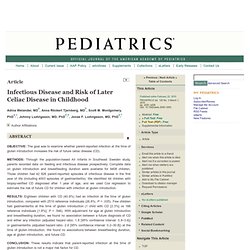
METHODS: Through the population-based All Infants in Southeast Sweden study, parents recorded data on feeding and infectious disease prospectively. Complete data on gluten introduction and breastfeeding duration were available for 9408 children. Those children had 42 826 parent-reported episodes of infectious disease in the first year of life (including 4003 episodes of gastroenteritis). RESULTS: Eighteen children with CD (40.9%) had an infection at the time of gluten introduction, compared with 2510 reference individuals (26.8%; P = .035). CONCLUSION: These results indicate that parent-reported infection at the time of gluten introduction is not a major risk factor for CD.
Key Words: Genetic and environmental factors affect the risk of developing CD. Participants Statistical Analyses Ethics Approval. Lung Cancer - Neutral risk of lung cancer in adults with celiac disease – nationwide cohort study. Received 21 March 2012; received in revised form 28 August 2012; accepted 3 September 2012. published online 28 September 2012.
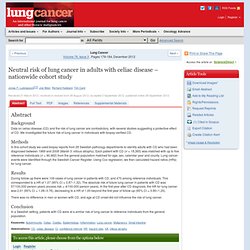
Background Data on celiac disease (CD) and the risk of lung cancer are contradictory, with several studies suggesting a protective effect of CD. Www.biomedcentral.com/content/pdf/1471-230X-9-57.pdf. Small-Intestinal Histopathology and Mortality Risk in Celiac Disease. Publications.ki.se/xmlui/bitstream/handle/10616/40923/Thesis_Adina_Welanderl.pdf?sequence=1. Celiac Disease: Complications and the role of Infection in Pathogenesis. Detection of Autoantibodies Against Actin Filaments in Celiac Disease - Porcelli - 2013 - Journal of Clinical Laboratory Analysis. Clinical Immunology and Immunopathology - Binding of Peptides from the N-Terminal Region of α-Gliadin to the Celiac Disease-Associated HLA-DQ2 Molecule Assessed in Biochemical and T Cell Assays. Why detection of celiac disease is important - USA. Biochemical markers of celiac disease - USA. Cerealchemistry.aaccnet.org/doi/pdf/10.1094/CCHEM-85-1-0001. American Journal of Gastroenterology - PPrevalence of Celiac Disease Among Relatives of Sib Pairs With Celiac Disease in U.S. Families.
Gastroenterology - Celiac disease in patients with an affected member, type 1 diabetes, iron-deficiency, or osteoporosis? Celiac disease (CD) may be a much under recognized condition, in part because it is not considered in those patients at high risk or in clinical conditions that may be a manifestation of CD.
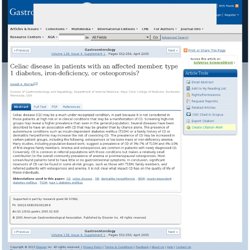
Screening high-risk groups may reveal a higher prevalence than seen in the general population. Several diseases have been described to have an association with CD that may be greater than by chance alone. The presence of autoimmune conditions such as insulin-dependent diabetes mellitus (T1DM) or a family history of CD or dermatitis herpetiformis may increase the risk of coexisting CD. The prevalence of CD may be increased in certain patient groups, including the following: osteoporosis or low bone mass or iron-deficiency anemia. Many studies, including population-based work, suggest a prevalence of CD of 3%–7% of T1DM and 4%–10% of first-degree family members. Supported in part by research grant DK 57982. Gastrointestinal Endoscopy - Significance of unsuspected celiac disease detected at endoscopy. Anemia of chronic disease and defective erythropoietin production in patients with celiac disease.
Abstract.
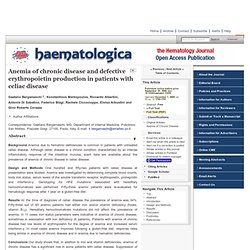
Www.manageceliac.com/Anemia in celiac disease multifactorial etiology.pdf. The Journal of Pediatrics - Celiac disease: A reappraisal. Received 21 February 1997; received in revised form 30 July 1997, 30 September 1997 and 10 December 1997; accepted 30 December 1997.

During the last decade significant changes have occurred in our concepts of celiac disease. As a result of the implementation of sensitive and specific serologic tests, the epidemiology and clinical presentation of affected patients have been radically reconsidered. Extraintestinal manifestations of celiac disease have been increasingly recognized, and the strict association with diseases recognized as autoimmune disorders is well established; celiac disease itself has many aspects of an autoimmune condition.
Celiac disease is of interest to clinicians and scientists because it represents a valuable model for the comprehension of diseases in which environmental, genetic, and immunologic factors interplay. (J Pediatr 1998;133:181-7.) Www.hkmacme.org/course/2010BW02-03-00/Gast CS_Feb10.pdf. American Journal of Gastroenterology - Abstract of article: Age-Related Clinical, Serological, and Histopathological Features of Celiac Disease. (2008) , 2360–2365; doi:10.1111/j.1572-0241.2008.01977.x To access a continuing medical education exam for this article, please visit www.acg.gi.org/journalcme .
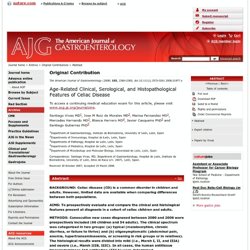
Santiago Vivas MD 1 , Jose M Ruiz de Morales MD 2 , Marisa Fernandez MD 1 , Mercedes Hernando MD 3 , Blanca Herrero MD 4 , Javier Casqueiro PhD 5 and Santiago Gutierrez PhD 5 1 Department of Gastroenterology, Instituto de Biomedicina, University of León, León, Spain 2 Departments of Immunology, Hospital de León, León, Spain 3 Departments of Pathology, Hospital de León, León, Spain 4 Departments of Pediatrics, Hospital de León, León, Spain 5 Department of Microbiology and Molecular Biology, Universidad de León, León, Spain Correspondence: Santiago Vivas, MD, Department of Gastroenterology, Hospital de León, Instituto de Biomedicina, University of León, Altos de Nava s/n. 24071, León, Spain. Received 30 October 2007; Accepted 25 March 2008. The American Journal of Medicine - Trends in the Presentation of Celiac Disease.
Received 25 February 2005; accepted 23 August 2005.
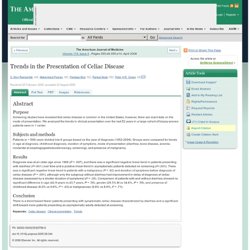
Purpose Screening studies have revealed that celiac disease is common in the United States; however, there are scant data on the mode of presentation. We analyzed the trends in clinical presentation over the last 52 years in a large cohort of biopsy-proven patients seen in 1 center. Subjects and methods Patients (n = 590) were divided into 6 groups based on the year of diagnosis (1952-2004). Results Diagnosis was at an older age since 1980 (P = .007), and there was a significant negative linear trend in patients presenting with diarrhea (P<.001) over time and a positive linear trend in asymptomatic patients detected on screening (P<.001).
Conclusion There is a trend toward fewer patients presenting with symptomatic celiac disease characterized by diarrhea and a significant shift toward more patients presenting as asymptomatic adults detected at screening. Keywords: Celiac disease, Clinical presentation, Trends. Emerging New Clinical Patterns in the Presentation of Celiac Disease.
Www.manageceliac.com/Effect of Gender on the Manifestations of Celiac Disease.pdf. Prevalence of Celiac Disease in At-Risk and Not-At-Risk Groups in the United StatesA Large Multicenter Study. Celiac Disease. On this page: What is celiac disease? Celiac disease is a digestive disease that damages the small intestine and interferes with absorption of nutrients from food. People who have celiac disease cannot tolerate gluten, a protein in wheat, rye, and barley. Gluten is found mainly in foods but may also be found in everyday products such as medicines, vitamins, and lip balms. The small intestine is shaded above. When people with celiac disease eat foods or use products containing gluten, their immune system responds by damaging or destroying villi—the tiny, fingerlike protrusions lining the small intestine.
Villi on the lining of the small intestine help absorb nutrients. Celiac disease is both a disease of malabsorption—meaning nutrients are not absorbed properly—and an abnormal immune reaction to gluten. [Top] Download.springer.com/static/pdf/229/art%253A10.1007%252Fs00281-012-0311-2.pdf?auth66=1362605299_3b961ecf6bbbdb3238c85429e26aa002&ext=.pdf.